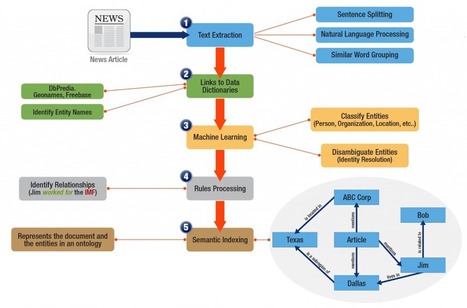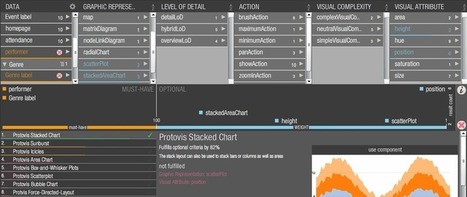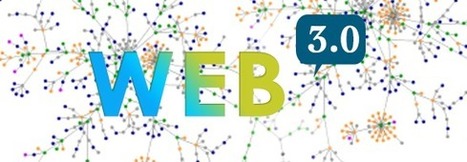In the not too distant past, analysts were all searching for a “360 degree view” of their data. Most of the time this phrase referred to integrated RDBMS data, analytics interfaces and customers. But with the onslaught…
Via Tony Agresta, Edward Chenard, juandoming



 Your new post is loading...
Your new post is loading...











Semantic pipelines allow for the identification, extraction, classification and storage of semantic knowledge creating a knowledge base of all your data. Most organizations have struggled to create these pipelines primarily because the plumbing hasn't existed. But now it does.
This post discusses how free flowing text streams into graph databases using concept extraction processes. A well coordinated feed of data is written to the underlying graph database while updates are tracked on a continuous basis to ensure database integrity.
Other important pipeline plumbing includes tools for disambiguation (used to resolve the definition of entities inside the text), classification of the entities, structuring relationships between entities and determining sentiment.
Organizations that deploy well functioning semantic pipelines have an added advantage over their competitors. They have instant access to a completed knowledge base of data. Research functions spend less time searching and more time analyzing. Alerting notifies critical business functions to take immediate action. Service levels are improved using accurate, well structured responses. Sentiment is detected allowing more time to react to changing market conditions.
In general, the REST Client API calls out a GATE-based annotation pipeline and sends back enriched data in RDF form. Organizations typically customize these pipelines which consist of any GATE-developed set of text mining algorithms for scoring, machine learning, disambiguation or any of the other wide range of text mining techniques.
It is important to note that these text mining pipelines create RDF in a linear fashion and feed GraphDB™. Once the RDF is enriched in this fashion and stored in the database, these annotations can then be modified, edited or removed. This is particularly useful when integrating with Linked Open Data (LOD) sources. Updates to the database are populated automatically when the source information changes.
For example, let’s say your text mining pipeline is referencing Freebase as its Linked Open Data source for organization names. If an organization name changes or a new subsidiary is announced in Freebase, this information will be updated as reference-able metadata in GraphDB™.
In addition, this tightly-coupled integration includes a suite of enterprise-grade APIs, the core of which is the Concept Extraction API. This API consists of a Coordinator and Entity Update Feed. Here’s what they do:
Other APIs include Document Classification, Disambiguation, Machine Learning, Sentiment Analysis & Relation Extraction. Together, this complete set of technology allows for tight integration and accurate processing of text while efficiently storing resulting RDF statements in GraphDB™.
As mentioned, the value of this tightly-coupled integration is in the rich metadata and relationships which can now be derived from the underlying RDF database. It’s this metadata that powers high performance search and discovery or website applications – results are compete, accurate and instantaneous.
- See more at: http://www.ontotext.com/text-mining-triplestores-full-semantic-circle/#sthash.fg1RVcQN.dpufIn general, the REST Client API calls out a GATE-based annotation pipeline and sends back enriched data in RDF form. Organizations typically customize these pipelines which consist of any GATE-developed set of text mining algorithms for scoring, machine learning, disambiguation or any of the other wide range of text mining techniques.
It is important to note that these text mining pipelines create RDF in a linear fashion and feed GraphDB™. Once the RDF is enriched in this fashion and stored in the database, these annotations can then be modified, edited or removed. This is particularly useful when integrating with Linked Open Data (LOD) sources. Updates to the database are populated automatically when the source information changes.
For example, let’s say your text mining pipeline is referencing Freebase as its Linked Open Data source for organization names. If an organization name changes or a new subsidiary is announced in Freebase, this information will be updated as reference-able metadata in GraphDB™.
In addition, this tightly-coupled integration includes a suite of enterprise-grade APIs, the core of which is the Concept Extraction API. This API consists of a Coordinator and Entity Update Feed. Here’s what they do:
Other APIs include Document Classification, Disambiguation, Machine Learning, Sentiment Analysis & Relation Extraction. Together, this complete set of technology allows for tight integration and accurate processing of text while efficiently storing resulting RDF statements in GraphDB™.
As mentioned, the value of this tightly-coupled integration is in the rich metadata and relationships which can now be derived from the underlying RDF database. It’s this metadata that powers high performance search and discovery or website applications – results are compete, accurate and instantaneous.
- See more at: http://www.ontotext.com/text-mining-triplestores-full-semantic-circle/#sthash.fg1RVcQN.dpuf